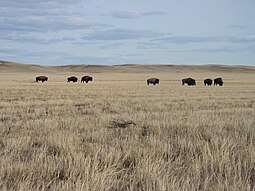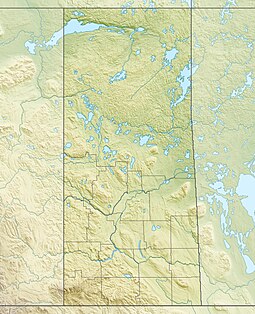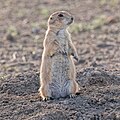Grasslands National Park
| Grasslands National Park | |
|---|---|
| Parc national des Prairies | |
 Bison grazing in Grasslands National Park | |
Location in Saskatchewan Location in Canada | |
| Location | RM of Val Marie No. 17, Saskatchewan, Canada |
| Nearest city | Val Marie |
| Coordinates | 49°09′N 107°31′W / 49.15°N 107.51°W |
| Area | 907 km2 (350 sq mi) |
| Established | 1981 |
| Visitors | 19,656 (in 2022–23[1]) |
| Governing body | Parks Canada |
| Grasslands National Park | |
 | |
Grasslands National Park is a Canadian national park located near the village of Val Marie, Saskatchewan, and one of 44 national parks and park reserves in Canada's national park system (though one of only two in Saskatchewan itself). This national park is north of the U.S. state of Montana and lies adjacent to the international boundary. It consists of two separate parcels, the East Block and West Block.
The park was established in 1981. Prior to this the province's only national park was Prince Albert National Park. Grasslands annually receives about 12,000 visitors.
Grasslands National Park represents the Prairie Grasslands natural region, protecting one of the nation's few remaining areas of undisturbed dry mixed-grass/shortgrass prairie grassland.[2] The park is located in the World Wildlife Fund-defined Northern short grasslands ecoregion, which spans much of southern Saskatchewan, southern Alberta, and the northern Great Plains states in the US. The unique landscape and harsh, semi-arid climate provide niches for several adapted plants and animals. The park and surrounding area house the country's only black-tailed prairie dog colonies. Fauna found in the park include bison, pronghorns, greater sage-grouses, ring-necked pheasants, burrowing owls, coyotes, ferruginous hawks, swift foxes, prairie rattlesnakes, black-footed ferrets, eastern yellow-bellied racers, and greater short-horned lizards.[3][4] Flora includes blue grama grass, needlegrass, plains cottonwood and silver sagebrush.[5]
History
[edit]
Erosion by glacial meltwater formed many of the park's characteristic features. Highlights of the park's geological landscape include the Frenchman River Valley, the Seventy Mile Butte, and the badlands of Rock Creek.
In 1874, Sir George Mercer Dawson discovered Western Canada's first dinosaur remains[6] in the Killdeer Badlands during the International Boundary Survey. Later, in 1877, Sitting Bull took refuge in the area with around 5,000 Sioux after the defeat of General Custer at the Battle of Little Bighorn.[7]
Grasslands National Park is on the traditional territory of the Blackfoot (Niitsítapi) people of the Canadian and American plains and is Treaty 4 land.[8] A 2022 agreement between the Métis Nation - Saskatchewan and Parks Canada provides for the transfer of 24 bison.[9]
West and East Blocks
[edit]
The West Block of the park is located one hour south of Swift Current, and the main visitor reception centre is located in the town of Val Marie. Highlights of the West Block include the Frenchman River Valley, a herd of over 300 plains bison as well as prairie dog colonies. A 16-kilometre (10 mi) wide stretch of land on either side of the Frenchman River is an Important Bird Area of Canada called Grasslands National Park (west) (SK 024).[10] Frenchman Valley Campground offers visitors serviced camping sites, teepee camping, and a cook shelter. Backcountry camping is also available.[11] The West Block is located in Census Division No. 4.
The East Block of the park is located about an hour's drive south of Assiniboia on the south side of the Wood Mountain Hills in Census Division No. 3. The interpretive centre is in the McGowan House at the new Rock Creek Campground and the information centre is at the museum in Wood Mountain Regional Park.[12] The East Block is more of a wilderness area but has views of the badlands of Rock Creek, the Cretaceous–Paleogene boundary, and prairie skies. A one-lane, 11-kilometre (6.8 mi) parkway traverses the Rock Creek Badlands.[13] The East Block contains the Grasslands National Park (east) (SK 023) Important Bird Area.[14]
In 2006, plains bison from Elk Island National Park in Alberta were reintroduced to Grasslands. By 2015 the herd had grown from the original 71 animals to over 300.[15] The herd is maintained on a 181 km2 (70 sq mi) section in the park's West Block. On 2 October 2009, in a ceremony at Belza House, the park was declared a dark-sky preserve,[16] and a small population of black-footed ferrets was reintroduced into the prairie dog towns after a 70-year absence. Improved night-lighting practices under the dark-sky agreement ensure that the park remains dark at night, preserving a natural environment for all nocturnal wildlife.[17]
Gallery
[edit]- Plants of the park
-
Plains prickly-pear cactus
-
Prairie onion
-
Wolf-Willow
-
Rubber rabbitbrush
-
Gumbo Evening Primrose
-
Foothill arnica
- Mammals of the park
-
American badger
-
Richardson's ground squirrel
-
Black-tailed prairie dog
-
Plains coyote
-
Mule deer
- Birds of the park
-
Horned lark
-
Loggerhead shrike
-
Prairie sharp-tailed grouse
-
Brown-headed cowbird
-
Eastern kingbird
-
Yellow-headed blackbird
See also
[edit]- List of National Parks of Canada
- List of protected areas of Saskatchewan
- List of protected grasslands of North America
- Tourism in Saskatchewan
References
[edit]- ^ Canada, Parks. "Parks Canada attendance 2022_23 - Parks Canada attendance 2022_23 - Open Government Portal". open.canada.ca. Retrieved 7 May 2024.
- ^ Whelan, Piper (3 May 2021). "The struggle to restore native prairie". Canadian Cattlemen. Archived from the original on 20 September 2021. Retrieved 20 September 2021.
- ^ "Ferrets, foxes and the fringed orchid: Species that suffer when grasslands are threatened". The Nature of Things: Science, Wildlife and Technology. CBC. Retrieved 12 October 2020.
- ^ "Grasslands National Park: Wildlife". Archived from the original on 5 June 2022. Retrieved 5 June 2022.
- ^ Camping in Grasslands National Park, Parks Canada, 24 November 2021, archived from the original on 9 February 2013, retrieved 28 September 2012
- ^ "Unique Places to visit in Saskatchewan". To Do Canada. 21 July 2023. Retrieved 30 March 2024.
- ^ Grasslands National Park of Canada: Human - Land Relationships - Human History, Parks Canada, archived from the original on 10 February 2013, retrieved 13 April 2012
- ^ "The Key First Nation, Welcomes Home Bison Herd Back To Treaty 4 Land". TDS News. 1 February 2022. Archived from the original on 17 March 2023. Retrieved 17 March 2023.
- ^ "Bison to once again roam lands around Batoche, Sask., after deal inked". CBC News. 20 November 2022. Archived from the original on 21 November 2022.
- ^ "Grasslands National Park (west) Val Marie, Saskatchewan". IBA Canada. Archived from the original on 14 October 2023. Retrieved 28 December 2022.
- ^ "Grasslands National Park Frenchman Valley Campground". Tourism Saskatchewan. Archived from the original on 27 March 2023. Retrieved 9 July 2022.
- ^ "Wood Mountain Regional Park". Wood Mountain. Archived from the original on 5 October 2022. Retrieved 28 December 2022.
- ^ "Rock Creek Badlands - Badlands Parkway". Tourism Saskatchewan. Government of Saskatchewan. Archived from the original on 31 October 2022. Retrieved 9 November 2022.
- ^ "Grasslands National Park (east) Killdeer, Saskatchewan". IBA Canada. Archived from the original on 9 July 2022. Retrieved 28 December 2022.
- ^ "Bison Again Roam Free in Canada's Grasslands National Park". Retrieved 2 April 2024.
- ^ "Parks Canada". World Class Astronomy. 29 January 2016. Archived from the original on 13 December 2016. Retrieved 2 October 2016.
- ^ Grasslands National Park, Parks Canada, archived from the original on 8 May 2012, retrieved 13 April 2012
External links
[edit]![]() Media related to Grasslands National Park at Wikimedia Commons
Media related to Grasslands National Park at Wikimedia Commons
 Canada portal
Canada portal- The Prairie Learning Centre
- "Northern Short Grasslands". Terrestrial Ecoregions. World Wildlife Fund.
- Grasslands National Park Archived 5 March 2016 at the Wayback Machine - Encyclopedia of Saskatchewan



















